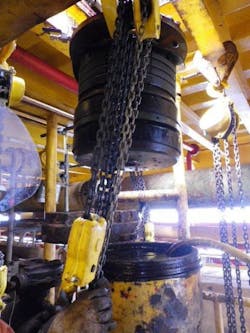Solutions must address cable strain, cooling
Torunn Lund Clase
Eldar Ystad
Nexans Norway
The offshore industry highlights flow assurance as vital to successful development of deepwater fields. The move towards even deeper waters and longer transportation distances presents a particular challenge for subsea production flowlines, as the combination of high pressures and low seawater temperatures can result in hydrate formation or wax deposits inside the flowline. These can limit or even block the flow, especially during operational shutdowns and tail production periods.
There are several solutions to prevent formation of hydrates during production. In the North Sea, the most common method combines thermal insulation and chemical injection. The disadvantage with this is that large amounts of chemicals are injected continuously into the well stream, then have to be removed again topside. This process incurs considerable operational costs, and may represent a risk to the environment.
Direct electrical heating (DEH) is an alternative for flow assurance, controlling the temperature on the flowline, and offering the potential to significantly reduce operating costs. Nexans Norway has pioneered development of DEH in partnership with Norwegian operators and research organizations. The company also has supplied cables and accessories for all DEH systems currently in operation worldwide.
How DEH works
In a DEH system, the pipe to be heated is an active conductor in the electric circuit formed by the dynamic DEH riser cable, the armored feeder cables (AFCs), the piggyback cable (PBC), and the flowline. The heating effect results from the fact that an electric current flowing in a metallic conductor generates heat.
A DEHS being transported for installation.
AC current comes from the topside power system through the DEH riser cable.
Subsea, the DEH riser cable is connected to the AFC in the subsea junction box. Using the AFC, one of the conductors in the DEH riser cable is linked to the flowline near end, while the other conductor is jointed to a PBC. The latter is connected to the flowline in the far end.
For safety and reliability reasons, the heating system is electrically connected to surrounding seawater (ie. it is an "open system") through several sacrificial anodes. These anodes must be rated for both corrosion protection and for sufficient grounding of the system during the expected lifetime of the flowline and the service life of the heating system.
Cable requirements
There are several challenges related to cables for DEH systems, especially for the PBC which is strapped to the flowline. Chief among these are:
1) Intermittent operation. The DEH is energized during shutdown and start-up. Rapid cooling of the power cables might cause condensation of water inside the cross-linked polyethylene (XLPE) insulation, leading to a phenomenon known as "water tree growth". Degradation of the insulation on power cables can cause build-up of microscopic, tree-like structures feeding on the condensed water. This in turn degrades the dielectric properties of the insulation, reducing breakdown strength and increasing dielectric loss, and impacting the lifetime of the cable.
2) Elongation/strain in the cable. The cable is anchored mechanically to the flowline by the cable-to-flowline terminations. During operation, the flowline experiences thermal expansion and contraction due to start-up and shutdown of the process (i.e., cooling when supply of warm liquid stops). Consequently, the tensile capacity of the cable is an important design parameter.
3) Impact loads.The PBC could be installed in areas with fishing activities (interaction with trawling gear) and the risk of dropped objects. A conventional submarine cable design with heavy outer armoring is not compatible with DEH, as the induced armor currents significantly reduce the efficiency of the system and cause high cable temperatures. Hence, the cable has to be protected by other means.
DEH installations
To meet these challenges, Nexans has carried out qualification testing for more than a decade. As a result, the company has designed cables and equipment to meet the specific needs of each DEH system. The world’s first DEH installation was performed in 2000 for Statoil’s Aasgard oil and gas field in the Norwegian Sea, where it serves to heat the flowlines from +6º C to +27º C (43-81º F) in order to prevent hydrate formation. The next installation was 2001 in the North Sea at the Huldra field, also operated by Statoil, on a 16-km (9.9-mi) flowline. Here the DEH system helps maintain the flowline temperature above +37º C (98.6º F) in order to prevent wax formation.
To date, Nexans has supplied cables and accessories to DEHs for 17 subsea flowlines across seven fields, totalling 180 km (112 mi) of PBC. In addition to Åsgard and Huldra, these include Kristin, Urd, Tyrihans, Alve, and Morvin. In early 2009, BP Norge contracted Nexans for cables and accessories for a DEH system for the Skarv field development in the Norwegian Sea. This will be installed on a 12-in. (30.5-cm) production flowline connecting one of the producer wells to the FPSO over a distance of 13 km (8 mi). The cables will be manufactures at Nexans’ specialized facility in Norway for installation next spring.






